Studies of creativity frequently focus on the modern era, yet creativity has always been part of human history. An understanding of creative inspiration thus requires that present-day studies are complemented by others investigating the past. This collaborative research project explores creativity during Middle and Late Bronze Age Europe (1800-800/500BC) through developments in decorative motifs, techniques and skill for three different materials: pottery, metal (bronze) and textiles. The Bronze Age saw key shifts in human history including metallurgy, long-distance contacts, and change in ritual life, accompanied by unprecedented flowering of craft activity with distinctive emphasis on the pleasing aesthetic through intricately elaborated objects. Crucially, this period precedes the development of the state and urbanism in which craft production became separated from the domestic sphere and the making of art recognised as a distinct activity. Furthermore, although the Bronze Age was a period of common cultural values, crafts were performed in regionally specific ways leading to diversity of practice with cross-fertilisation between materials and cultural groups. The Bronze Age is therefore a critical moment for understanding the dynamics of creativity in cultural products.
These changes have previously been analysed primarily in social or economic terms, neglecting the creativity that underpinned them. Moreover, neither temporal and spatial variations, nor differences between materials, have been investigated in terms of creativity in the Bronze Age. In addition, the potential impact these objects may have today as a source of inspiration and means of creative engagement for different groups, including craftspeople, has never been considered. This project responds to these challenges by investigating Bronze Age objects as a means to gaining insights into creativity.
During the Middle and Late Bronze Age there were only modest technological changes: types of looms remained basically the same; methods for casting objects were established; potting techniques were not substantially altered. Changes in material culture are therefore due to development of technical skill and new ways of designing objects, exploiting the potentials of materials – in particular their surfaces and different plasticities. These developments, rather than technological innovation or typological changes per se, constitute the creativity and innovations to be investigated.
These changes are different for each material, reflecting different properties, kinds of experimentation and decision-making processes. For pottery, there is sophisticated, complex and varied treatment of clays, use of distinct colour effects including black vessels, and more elaborately decorated surfaces combining a variety of finishes and decorative techniques. Bronze objects are cast, twisted or beaten into complex shapes, techniques of surface decoration such as repoussé become common, and new motifs appear. For textiles, important changes concern the production of patterned surfaces, the selection of raw materials, the introduction of dyes, and the elaboration of surfaces through embroidery.
The research comprises comparative studies of these materials in three regions forming a north-south axis: Scandinavia, Central Europe and the Adriatic. It focuses on the development of craft-skills and stylistic characteristics, drawing comparison through both similarities and differences. Examination of contemporary engagements with Bronze Age objects informs on the relationship between ancient and modern creativity.
The research is structured around 4 shared specific analytical concerns:
1) The qualities of materials: characteristics and particular potentials of each material. How did the innate qualities of each material inspire, guide and restrict the production of objects? What specific decisions were required to work with them? For example: How were complex textile surface designs accomplished in weaving? How did the qualities of metal surfaces make it possible to develop new figurative designs such as the decorative compositions on razors? How was the plasticity of clay explored to create new and elaborately shaped pottery forms?
2) Motifs and skills: investigation of the development of skill and motifs, and comparisons between the materials in terms of technical relationships and cross-material influences through the transfer of knowledge. For example, what decorative schemes develop on pottery and which of these are shared with textiles or bronze? What technical solutions developed and which are shared between materials (such as use of moulds)?
3) Spatial and temporal trends: tracing changes within and between materials in terms of the patterns identified under 1 and 2. How did the practice of each craft develop and how did changes in one region inspire imitations and developments elsewhere? For example, was patterned weaving developed independently in different parts of Europe and to what extent did designs in textile production become shared?
4) The perception of prehistoric craft today. How do different contemporary groups respond to the creativity embedded in prehistoric objects? How do modern craftspeople engage with such objects, interpret the decision-making processes required to make them, and use them as the basis for their own creativity? For the public, does participating in the reproduction of prehistoric objects inspire people to think about how things are made and challenge their understanding of creativity? Furthermore, how does the classification of an object as a souvenir affect its understanding?
This project moves beyond the state of the art to understand creativity through the time depth offered by archaeology and a focus on craft prior to the separation of art from the domestic. Furthermore, whereas there is a long tradition of investigating technological, typological and stylistic developments within pottery, textiles and metal, such work has not previously been connected with the concept of creativity, nor have the developments in the different materials been compared and contrasted. Our emphasis on the material aspects of creativity allows an original understanding of how creative possibilities are generated and how their expressions change over space and the long dureé. Within heritage and museum studies, much attention has been given to visitor experience but this has not included explicit investigation of how people today may find inspiration from engaging with prehistoric objects (the inherently valuable). This is important since it provides the basis for new types of heritage experiences in which creative potentials of objects are more imaginatively explored, as well as offering inspiration and new roles for the contemporary craft sector.


 Follow us on
Follow us on 